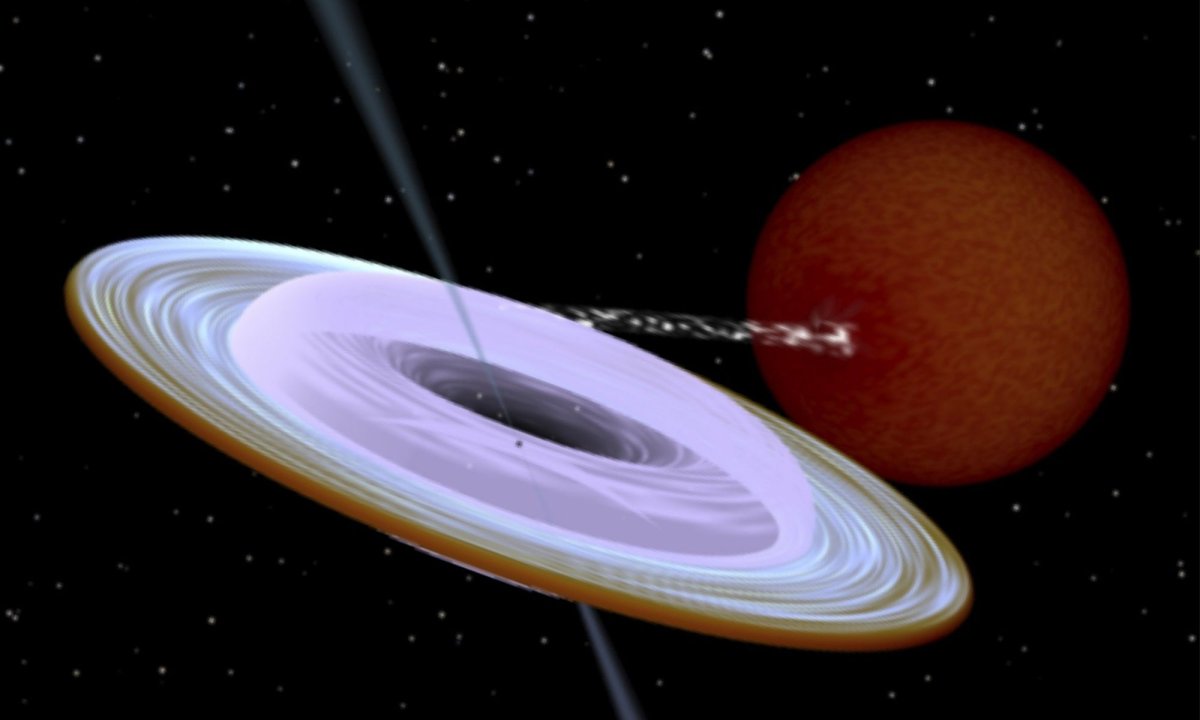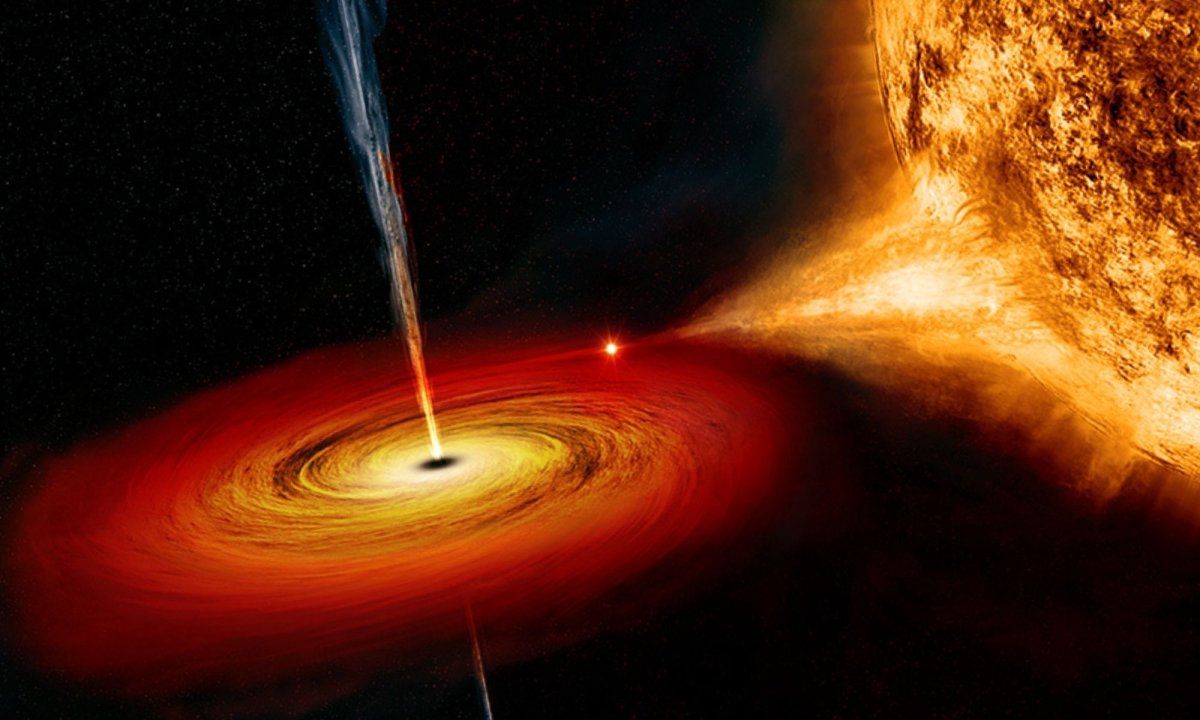Astronomers have discovered a distant binary arrangement that contains the most tilted black hole system ever found, consisting of a black hole feeding on material snatched from a companion star.
The misalignment between the two cosmic bodies (in what is known as an x-ray binary) is so extreme that it could force scientists to change models that explain how black holes form.
In a perspectives article due to be published in the journal Science, European Southern Observatory astronomer Ferdinando Patat and University of Padova professor of astronomy Michela Mapelli explain the misalignment could be due to: "the presence of a powerful kick produced by the supernova that generated the black hole."
The x-ray system binary studied by the team was MAXI J1820+70 located in the Milky Way and around 1,000 light-years from Earth.
The system consists of a black hole with a mass around eight times that of the sun and a companion star with just half our star's mass. The black hole launches jets of material at around 80 percent the speed of light, which the astronomers used to discover a misalignment of 40 degrees.
Manuel Torres, a researcher formerly from the Harvard-Smithsonian Center for Astrophysics, and now based at the Instituto de Astrofisica de Canarias in Spain, told Newsweek: "MAXI J1820+70 is an exceptional black hole binary, its location in the sky relatively nearby to Earth and barely shrouded by interstellar gas permitted us to not only to study its outburst with great detail, but also the radiation emitted by the binary components after it ended its activity."
Torres, the author of a second paper detailing the team's findings also published in Science, said a detailed picture of the architecture of the binary and orientation of their components led to the discovery of the large misalignment in the system.
Representing the largest offset ever found in such a system, this tilt in MAXI J1820+70's alignment could have been placed in the system when the black hole was created.
Astrophysics Research Institute at Liverpool John Moores University researcher, and paper co-author, Helen Jermak, told Newsweek: "We did not expect there to be a large misalignment in this system. This discovery challenges our understanding of black hole formation in binary systems and will affect the way we determine the properties of black holes."
Putting A New Spin On Black Hole Formation
Almost all cosmic bodies from small planets to huge supermassive black holes rotate on an axis. When these bodies are part of a gravitationally bound system their individual rotational axis are aligned.
For systems that consist of a collapsed star (such as a white dwarf, neutron star, or a black hole, and a star orbiting around each other, known as an x-ray binary) these axes are aligned and are at 90 degrees, or perpendicular, to the orbital plane in which they sit.

When a black hole in one of these binary systems is close enough to its companion star, it will strip material from this star. This material forms what is called an accretion disc encircling the black hole and gradually falling to its surface.
The tremendous gravitational forces created by black holes result in extreme and violent conditions in these accretions discs. This results in the material in the disc being heated to tremendous temperatures or even destroyed, causing the emission of optical and x-ray radiation.
In addition to this, material that escapes accretion onto the black hole and falls to its poles is launched into space as beams of ionized gas called relativistic jets along the black hole's axis.
Both these x-ray and optical emissions, and the relativistic jets, which can often spread out many of light-years, can be used to characterize these black holes and their fundamental properties, with black holes believed to be capable of possessing just three characteristics: mass, charge, and angular momentum or spin.
Specifically, observations of x-ray emissions have been used to characterize the spin of the black hole at the center of the accretion disc. But, these models have assumed that the axis of the black hole is not misaligned.
This isn't the case with MAXI J1820+70 that has a 40-degree misalignment in its orientation. The reason this has consequences for black hole formation theories arises from the fact that mass accretion and tidal forces always bring the axes of black holes and their companion stars closer into alignment.
The authors of the Science paper reason that this means that the misalignment seen in MAXI J1820+70 must be an artifact of formation.
Mapelli and Patat write that when stars undergo the supernova explosion that ends their lives, mass is ejected asymmetrically. This gives the new black hole what they call a "natal kick."
This kick could cause an orbital misalignment between the black hole and its binary companion star. Jermak from John Moores, said: "The system originally consisted of two stars. The massive star collapsed at the end of its life to form a black hole.
"The misalignment might imply that when the massive star core collapsed it was asymmetric. This could have given the black hole a large kick during its formation."
The theory implies this misalignment was actually greater in the past and has been reversed somewhat as the companion star donated material to the black hole.
Jermak added: "We now have good observational evidence that the misalignment can be rather large. Before this discovery, the assumption was that the misalignment is small or even negligible.
"This new discovery affects the way researchers determine black hole masses and their spins."
Torres concluded: "Now that J1820 is in its dormant state, we will be able to observe the companion star with great detail. By tracking its orbital motion it will be possible to establish with much higher precision the inclination of the binary and quantify better the degree of misalignment.
"All this information will make it possible to test theories that predict the formation of black holes from the collapse of massive stars at the end of their lives."
Correction 2/25/22, 3:57 a.m ET: This article was updated to correct Helen Jermak's title and to include where Manuel Torres currently works.

Uncommon Knowledge
Newsweek is committed to challenging conventional wisdom and finding connections in the search for common ground.
Newsweek is committed to challenging conventional wisdom and finding connections in the search for common ground.
About the writer
To read how Newsweek uses AI as a newsroom tool, Click here.








